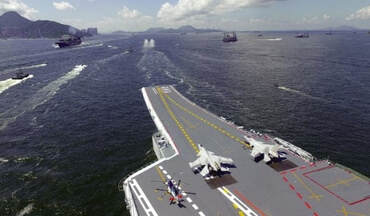New commercial satellite photos published by the Center for Strategic and International Studies in Washington show what is almost certainly the early stages of construction of China’s third aircraft carrier in Jiangnan Shipyard and there’s a chance that this behemoth with an approximate 80,000 tons displacement might have nuclear propulsion. The earlier two ships which have displacements of 60,000 – 70,000 tons of displacements were refit and built in the Dalian Shipyard… …
This new vessel will be a major leap in capability compared to the earlier two ships the PLAN has sailed so far—and it represents the evolution of Chinese carrier aviation from an adapted Soviet model to a Western-style fleet, one that reflects China’s ambition and doctrine to be the leading strategic power in oceans surrounding Asia.
China’s military modernization, its carrier program and other developments are a process of copying, adaptation, and innovation. The copying part came first. China bought the former Soviet aircraft carrier Varyag—which was little more than a rusting hulk—and built a respectable midsize ship, the Liaoning, which is now evolving from a mere training vessel to one with some real fangs and claws operational capabilities. China got the blueprints for the ship from the Ukraine, too, but it didn’t just finish the ship as the old Soviet Navy intended—it adapted and innovated to match its ambitions and doctrines.
Soviet carriers of the late 1980s were built with a different purpose in mind than that of the U.S. carriers which are gigantic floating airfields that allow power to be pushed far from the shores of the Continental United States. The Soviets constructed their aircraft carriers with an entirely different operational concept in mind: protecting the near seas against foreign aircraft and surface ships. Soviet ships were smaller and armed with a battery of huge long-range anti-ship missiles under the flight deck. Which literally made them cruisers with a couple dozen fighter aircraft on board rather than true U.S.-style super carriers.
One of the first things China’s naval engineers did with their ex-Soviet vessel was to remove the missile battery which they deemed inconsistent with their own operational doctrine. It was clear from the outset that the PLAN had a different purpose in mind for the refurbished vessel other than the primarily defensive Soviet modus operandi. Getting rid of those missile batteries meant that the refurbished ship would be devoted purely to operating aircraft and would be the centerpiece of the PLAN’s ambitions to operate far from its shore
The limitations of the Soviet-era design are presenting obstructions to those ambitions, one of which comes in the form of a so-called ski jump ramp at the bow of the ship that gives aircraft the extra lift they need to take off from a very short runway. It’s a foolproof system, as it has no moving parts, but there’s a big trade-off as it puts big limits on the size of aircraft that can take off from the ship and the amount of fuel and weapons they can carry. This implies that critical support tasks such as airborne early warning and supply delivery have to be performed by helicopters, which are slower and have range restrictions and a lacks endurance.
That distinctive ski jump design (also known as STOBAR) was carried over to China’s second carrier, launched last year and is now undergoing sea trials. Regardless of that it is highly likely that the carrier now under construction will abandon the limiting STOBAR ski jump ramp system for something more sophisticated and capable. The CSIS satellite photos show that China is working on two different kinds of catapult launch technology (also known as CATOBAR), which can fling even large and heavy aircraft off a ship at high speeds. One is a steam catapult, used on the current generation of U.S. carriers, and the other is an electromagnetic version, which the United States is now struggling to perfect on its latest carrier, the USS Gerald Ford. The electromagnetic aircraft launch system will mean less wear and tear on the planes and it will allow more aircraft to be launched in a shorter time in comparison to the STOBAR systems.
The layout of the new aircraft carrier, including its flight deck and “island” command center, would be different from the earlier two. The new carrier will have a smaller tower island compared to the Liaoning and its sister ship because China’s carrier-based J-15 fighter jets, which are quite large in size, are planned to be accommodated on it.
It’s not yet known which of these two systems will appear on the new carrier, but either way, the use of catapults will make this new ship far more combat-capable than its two predecessors. And it won’t be the end of the evolutionary process: China is likely to develop a stealth fighter, likely the Shenyang J-31, for its carrier fleet in a similar class to the F-35—and an airborne early warning plane might also be in the pipeline, judging by the drawings and mock-ups seen thus far, will look remarkably similar to the U.S. Navy’s E-2 Hawkeye (more copying and adaptation)—and eventually a nuclear-powered carrier.
SCMP, The Diplomat

